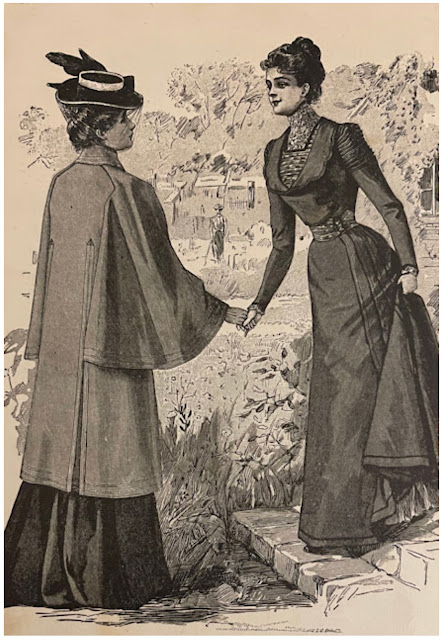Prodigious as are the manuals of etiquette issued in these days, nobody with a kind heart, a desire to please and the merest rudiments of knowledge of the simpler social responsibilities need worry about their “manners.” The self-respect that a good conscience and self-reliance give will keep you from pushing and intruding. As for “rules of conduct,” pooh ! You need hardly bother about any that your own sense does not suggest."
Arbitrary rules of etiquette, such as concern the proper way to shake hands, the number of cards to be left at a reception, the way to turn out your toes and the special greeting that is the current fad, all these rules are liable to change from season to season, vary in different localities and mean very little anyhow. A handshake that is the result of cordial intent can never be rude nor ill done. Bad temper is always ill-bred. Conduct of any kind that puts others to distress is always “bad manners,” disrespect to age or to the dignity that office or high achievement confers is always hopeless rudeness, and your own good heart will tell you that.
The young girl just out of school is overwhelmed with mustn'ts and musts, but most of them are nonsense. If she is modest and self-respecting she will know that the inevitable “young man” must be treated with some reserve. But she need not be afraid to take his arm if she needs his assistance, nor has she committed a social crime if she doesn't take it, so long as neither course is followed to her own distress, or to his unnecessary embarrassment.
Arbitrary rules of etiquette, such as concern the proper way to shake hands, the number of cards to be left at a reception, the way to turn out your toes and the special greeting that is the current fad, all these rules are liable to change from season to season, vary in different localities and mean very little anyhow. A handshake that is the result of cordial intent can never be rude nor ill done. Bad temper is always ill-bred. Conduct of any kind that puts others to distress is always “bad manners,” disrespect to age or to the dignity that office or high achievement confers is always hopeless rudeness, and your own good heart will tell you that.
The young girl just out of school is overwhelmed with mustn'ts and musts, but most of them are nonsense. If she is modest and self-respecting she will know that the inevitable “young man” must be treated with some reserve. But she need not be afraid to take his arm if she needs his assistance, nor has she committed a social crime if she doesn't take it, so long as neither course is followed to her own distress, or to his unnecessary embarrassment.
She will know that this same young fellow should include her mother or guardian in social plans, at least till such time as the mother or guardian have judged him to be trusted with the escort of the girl alone. Her own instinct will tell her that she should not receive rich presents from a man unless she is engaged to him, because it is never comfortable to be under obligations to any one, whether a “young man” or not, that she is not in a position to repay. All the other mustn't easily range themselves under some equally simple and reasonable rules.
Many of the remaining causes of anxiety to the neophyte come under the head of prompt and exact replies to social notes involving the making of social engagements, of equally careful keeping of social engagements, big and little, of friendly thoughtfulness of the one who is ill, or who is having an anniversary of some kind that demands a call, or a line of remembrance or greeting. Then there are “table manners,” and they are made such a bugbear that one's appetite is all lost. But even at the most formal dinner you need not be afraid. Watch the hostess. She is supposed to set the example for every one.
Don't be frightened, and don't do anything in a hurry. Indeed, those two suggestions will bring you through almost any formal occasion if you will keep sharp lookout and remember that good temper and a modest desire to please will make up for mere awkwardness and make up handsomely. – A “Second Debut” Article by C. O. Burton, 1895
Many of the remaining causes of anxiety to the neophyte come under the head of prompt and exact replies to social notes involving the making of social engagements, of equally careful keeping of social engagements, big and little, of friendly thoughtfulness of the one who is ill, or who is having an anniversary of some kind that demands a call, or a line of remembrance or greeting. Then there are “table manners,” and they are made such a bugbear that one's appetite is all lost. But even at the most formal dinner you need not be afraid. Watch the hostess. She is supposed to set the example for every one.
Don't be frightened, and don't do anything in a hurry. Indeed, those two suggestions will bring you through almost any formal occasion if you will keep sharp lookout and remember that good temper and a modest desire to please will make up for mere awkwardness and make up handsomely. – A “Second Debut” Article by C. O. Burton, 1895
🍽Etiquette Enthusiast, Maura J Graber, is the Site Editor for the Etiquipedia © Etiquette Encyclopedia











